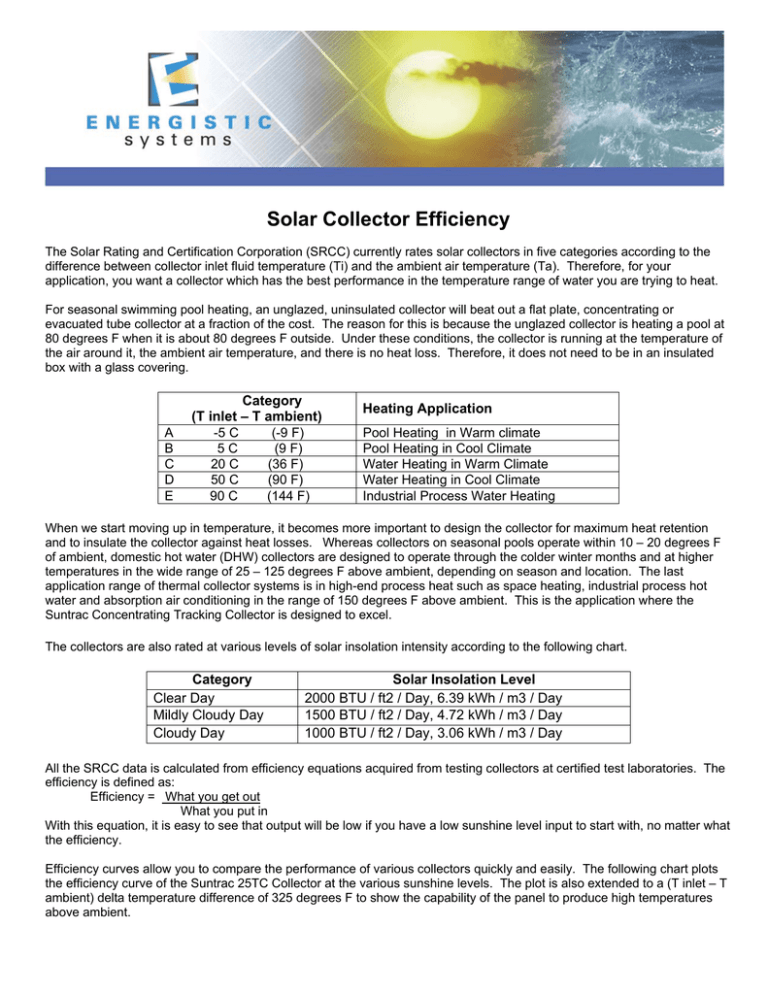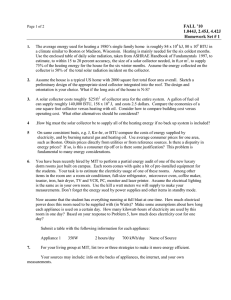Solar Collector Efficiency
advertisement

Solar Collector Efficiency The Solar Rating and Certification Corporation (SRCC) currently rates solar collectors in five categories according to the difference between collector inlet fluid temperature (Ti) and the ambient air temperature (Ta). Therefore, for your application, you want a collector which has the best performance in the temperature range of water you are trying to heat. For seasonal swimming pool heating, an unglazed, uninsulated collector will beat out a flat plate, concentrating or evacuated tube collector at a fraction of the cost. The reason for this is because the unglazed collector is heating a pool at 80 degrees F when it is about 80 degrees F outside. Under these conditions, the collector is running at the temperature of the air around it, the ambient air temperature, and there is no heat loss. Therefore, it does not need to be in an insulated box with a glass covering. A B C D E Category (T inlet – T ambient) -5 C (-9 F) 5C (9 F) 20 C (36 F) 50 C (90 F) 90 C (144 F) Heating Application Pool Heating in Warm climate Pool Heating in Cool Climate Water Heating in Warm Climate Water Heating in Cool Climate Industrial Process Water Heating When we start moving up in temperature, it becomes more important to design the collector for maximum heat retention and to insulate the collector against heat losses. Whereas collectors on seasonal pools operate within 10 – 20 degrees F of ambient, domestic hot water (DHW) collectors are designed to operate through the colder winter months and at higher temperatures in the wide range of 25 – 125 degrees F above ambient, depending on season and location. The last application range of thermal collector systems is in high-end process heat such as space heating, industrial process hot water and absorption air conditioning in the range of 150 degrees F above ambient. This is the application where the Suntrac Concentrating Tracking Collector is designed to excel. The collectors are also rated at various levels of solar insolation intensity according to the following chart. Category Clear Day Mildly Cloudy Day Cloudy Day Solar Insolation Level 2000 BTU / ft2 / Day, 6.39 kWh / m3 / Day 1500 BTU / ft2 / Day, 4.72 kWh / m3 / Day 1000 BTU / ft2 / Day, 3.06 kWh / m3 / Day All the SRCC data is calculated from efficiency equations acquired from testing collectors at certified test laboratories. The efficiency is defined as: Efficiency = What you get out What you put in With this equation, it is easy to see that output will be low if you have a low sunshine level input to start with, no matter what the efficiency. Efficiency curves allow you to compare the performance of various collectors quickly and easily. The following chart plots the efficiency curve of the Suntrac 25TC Collector at the various sunshine levels. The plot is also extended to a (T inlet – T ambient) delta temperature difference of 325 degrees F to show the capability of the panel to produce high temperatures above ambient. SunTrac Collector Efficiency 0.8 0.7 % Efficiency 0.6 0.5 0.4 0.3 0.2 0.1 0 -9 9 36 75 100 144 175 225 275 325 (T inlet - T ambient) Degrees F Delta Clear Mostly Clear Mildly Cloudy Mostly Cloudy The following graph compares the performance of the SunTrac Concentrating Tracking Collector with two of the leading flat plate collectors. As you can see, at the lower temperature difference levels, the panels all perform about the same. As the temperature difference increases, the curves show the performance advantage of the SunTrac Concentrating Collector. % Efficiency Collector Efficiency Comparison Curves Clear Day Sun of 300 BTU / Ft2 / Hour 0.8 0.7 0.6 0.5 0.4 0.3 0.2 0.1 0 -9 0 9 36 90 144 200 225 250 300 325 (T Inlet - T ambient) Degrees F Delta SunTrac Concentrator Series4 Series8 Series2 SunEarth EC Flat Plate Series10 Gobi Flat Plate Series6 To see for yourself how much more cost effective and efficiently the SunTrac 25TC will work in your application, first select the operating temperature you want and then subtract the air temperature for your location. For space heating and industrial process hot water applications, choose the low average daytime air temperature for the coldest winter month. For an absorption air conditioning application, choose the summer average daytime air temperature. Example 1: A plant requires process hot water and space heating at an inlet temperature of Ti = 215 F and during the winter the daytime ambient air temperature is Ta = 15 F. This results in a Ti – Ta of 200 F. The efficiency of the Suntrac panel is 36%. Now compare the efficiency of the other two flat plate collectors. One has an efficiency at 200 F delta T of 20% and the other panel has 22%. It will therefore take 80% more square feet of the flat plate collectors to match the SunTrac heating capacity. Example 2: An office building has an absorption air conditioning system that requires an inlet temperature of Ti = 340 F water temperature and the summer air temperature is Ta = 90 F. This results in a Ti – Ta of 250 F. The SunTrac 25TC has an efficiency of 27.2% at this temperature differential. The best flat plate collector has about an11% efficiency and the other panel has 6.6% efficiency. That means you would need between three to four times as much flat plate collector surface area compared to the SunTrac 25TC collector. Remember, the efficiency tells you what percentage of the sun’s energy the collector turns into heat. A collector that has twice the efficiency requires only half as many square feet of collector surface area to capture the same amount of heat energy.


